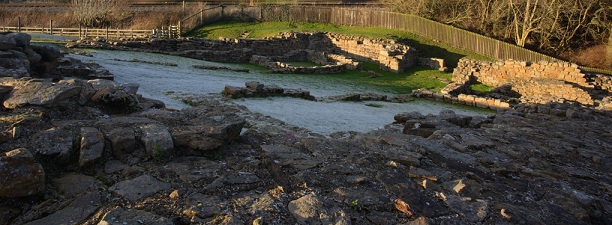Haltwhistle Station was opened in 1838 along with the rest of the section west of Hexham. The station itself is said to be the work of the line’s engineer John Blackmore. It used to be a junction station when the branch line to the town of Alston was open. A section of which is now in use by the South Tynedale Railway, who have plans to extend their track to Haltwhistle.
Today, the station itself has a lovely Old Booking Hall (used by the Tyne Valley CRP and for community and educational events) and an imposing signal box. Restoration of the waiting rooms and redundant station buildings is currently being undertaken.
The town of Haltwhistle hosts many different attractions. The town itself claims to be the geographical centre of Grea t Britain and has a plaque on the ground in the market place to commemorate this unique aspect.. When wandering around the marketplace you would find it host many different types of shops, cafés and pubs.
t Britain and has a plaque on the ground in the market place to commemorate this unique aspect.. When wandering around the marketplace you would find it host many different types of shops, cafés and pubs.
Situated on the South Tyne river, it is only a few miles from some of the best remaining sections of Hadrian's Wall. It is possible to walk from the town to the Wall via Haltwhistle Burn. This and other local walks are described in the Haltwhistle Partnership website
Wander around the Market Place and you will find the 13th Century Church of the Holy Cross. Close by is the Centre of Britain Hotel with its Pele Tower incorporated into the building. With Border Reivers connections, you can follow the Reiver Trail around the town; you will see five other Bastle Houses (defensible houses) all of which date back to the Town's reiving past.
For further information see the Haltwhistle Partnership website www.haltwhistle.org
The year-round 185 bus provides a great way of travelling from Haltwhistle to sites on Hadrians Wall including:
Birdoswald, CA8 7DD
Birdoswald is a  Roman Fort built towards the western end of Hadrian’s Wall and is yet another English Heritage site. In Roman times it was known as Banna; its strategic position overlooks some cliffs and is close to the River Irthing. Today, Birdoswald sits on the longest continuous stretch of Hadrian’s Wall as well as a Roman Fort and a milecastle.
Roman Fort built towards the western end of Hadrian’s Wall and is yet another English Heritage site. In Roman times it was known as Banna; its strategic position overlooks some cliffs and is close to the River Irthing. Today, Birdoswald sits on the longest continuous stretch of Hadrian’s Wall as well as a Roman Fort and a milecastle.
It is also a great place to visit for all age groups and is a great place for families. There is a new exhibition which can be found in the gatehouse and there are many other activities to do such as; brick making for the children, a quiz and also the facility to take a look through a periscope to see the same view as that seen by the Roman look-outs.
Birdoswald is an English Heritage property and ou can find out more about Birdoswald and planned events here.
Poltross Burn: Gilsland, Cumbria, CA8 7BJ

Poltross Burn Milecastle is two miles from Birdoswald and is said to be Milecastle number 48. For a long time was known throughout the area as The King’s Stables. It stands on the west bank of the Poltross Burn tributary of the River Irthing, within the village of Gilsland. It is one of the most well-preserved milecastles along the wall. Larger than many of the other milescastles,the north and south gatrs, enclosing walls and a pair of small barrack blocks are evident. The Milecastle is located right next to a section of the Tyne Valley Railway embankment and boasts stunning scenery across the Valley.
Walks
You can find links to many walks in and around on the Haltwhistle Partnership website
Transport Integration
The station provides a local transport hub connecting the trains arriving at Haltwhistle station to the North Pennines bus to Alston and the South Tynedale Railway. More information about these and other buses available from the Railway Station can be found here.

